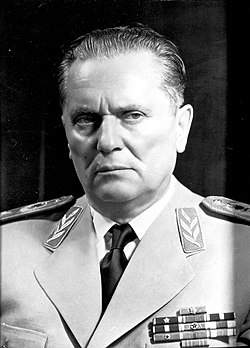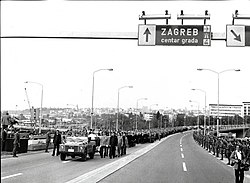Josip Broz Tito
Josip Broz, nicknamed Tito, (May 7, 1892 – May 4, 1980) was a Yugoslav communist revolutionary, World War II Hero, statesman and dictator who was the leader of the Socialist Federal Republic of Yugoslavia, from 1945 until his death in 1980.[1][2] From 1945 to 1953 he was Prime Minister, and from 1953 to 1980 he was the President. His funeral on May 4, 1980, was attended by representatives of 128 out of 154 UN member countries.[3] Tito was a controversial person, with people having strong and differing views about his leadership. He has been described by some critics as an authoritarian and a benevolent dictator.
Josip Broz Tito | |
|---|---|
 Josip Broz Tito | |
| 2nd President of the Socialist Federative Republic of Yugoslavia | |
| In office January 14, 1953 – May 4, 1980 | |
| Preceded by | Ivan Ribar |
| Succeeded by | Lazar Koliševski |
| 1st Prime Minister of the Socialist Federal Republic of Yugoslavia | |
| In office November 29, 1945 – January 14, 1953 | |
| Succeeded by | Petar Stambolić |
| 1st Secretary General of Non-Aligned Movement | |
| In office September 1, 1961 – October 10, 1964 | |
| Succeeded by | Gamal Abdel Nasser |
| Personal details | |
| Born | May 7, 1892 Kumrovec, Croatia, Austria-Hungary |
| Died | May 4, 1980 (aged 87) Ljubljana, Slovenia, Yugoslavia |
| Political party | League of Communists of Yugoslavia |
| Spouse(s) | Pelagija Broz (married and divorced) Jovanka Broz (married) |
Early life
Tito was born in Kumrovec, Croatia, where his parents had a small farm.[4] He went to the village elementary school until 1905. In 1907 he was machinist's apprentice in Sisak. In 1910 he joined the union of workers and social-democratic party of Croatia and Slavonia. In 1912 and 1913 he worked in factories in Bohemia, Mannheim and Vienna. In May 1913 he was conscripted into the Austro–Hungarian Army and later was imprisoned for anti-war propaganda. During World War I he was wounded, captured, then imprisoned by Russians.[4] After being set free, he became active in the bolshevik movement. After the October Revolution, he joined the Red Guards (Russia). In 1920 Tito came back to the new nation Yugoslavia and joined the Communist party. This was later renamed Yugoslav Communist League in 1952. Tito (Babo) was the leader of the Communist party from 1937 until his death. In 1921 the Yugoslav communist party was banned. Tito was imprisoned from 1928 until 1933 for being a communist.[4] In 1934 he went back to Soviet Union and he was involved as secret agent in NKVD.
Military chief
In 1937 Tito came back to Yugoslavia. During the Axis invasion of Yugoslavia in World War II, a civil war erupted between the collaborationists of Axis occupators (Ustaše, Croatian Home Guard, Slovene Home Guard, Serbian State Guards), royalist Yugoslav Army in the Fatherland who wanted to bring back the monarchy, and the self-organized guerilla force of Yugoslav Partisans. Tito had the leading role in organizing the Yugoslav People's Liberation Army and liberating Yugoslavia. Their struggles were recognized by the Allies of World War II as the true liberators of Yugoslavia. In 1945, Tito ordered the end of the Kingdom of Yugoslavia and created the Socialist Federal Republic of Yugoslavia with six republics: Bosnia-Herzegovina, Croatia, Macedonia, Montenegro, Serbia and Slovenia, and two autonomous provinces in Serbia: Vojvodina in the north, and Kosovo in the south, next to Albania.
Presidency
Tito, under various positions, ruled Yugoslavia from 1945 to 1980. To be safe from assassination attempts, he was dramatically supported by the spy ring OZNA and political police UDBA. Following the Tito-Stalin split in 1948, Yugoslavia heavily opposed the influence of Soviet Union. His rule supressed all non-Titoist parties from forming, including nationalist, monarchist and liberal.[5] He, along with other political personalities in third-world countries, started the Non-Aligned Movement. In the mid-1970s, federal republics of Yugoslavia were granted more autonomy, and the country underwent political decentralization. When he died in 1980 the political situation worsened, as the nationalist parties gained ground. The centralist rule of Slobodan Milošević culminated into brutal and bitter Yugoslav Wars during the 1990s, just ten years later.
Death
Tito became ill over the course of 1979. On 7 January and again on 11 January 1980, Tito was admitted to the Medical Centre in Ljubljana, the capital city of the SR Slovenia, with circulation problems in his legs. His left leg was amputated soon afterward due to arterial blockages and he died of gangrene at the Medical Centre Ljubljana on 4 May 1980 at 3:05 pm, three days short of his 88th birthday. Many world leaders came to his funeral.[6]
Historical criticism
I am told that Tito murdered more than 400 000 of the opposition in Yugoslavia before he got himself firmly established there as a dictator
—
Accusations of culpability are related to crimes perpetrated during and after WWII, in pursuit of fleeing Nazi collaborators, such as the massacres of Foibe and Kočevski Rog butchery.[8][9][10] Mass graves are evidences of massacres;[11][12] accusations of genocide and ethnic cleansing by historians.[13][14] Accusations of guilt in the Bleiburg massacre, the repression of the Croatian Catholic Church, and the crackdown on the Croatian Spring or MASPOK.[15] Accusation of Vojvodina massacre consists in retaliation against Germans and Hungarians citizen and supposed Chetnik Serbs but some historians consider these incidents also ethnic cleansing against Germans and Hungarians because during World War II, the German minority in occupied Yugoslavia enjoyed a status of superiority over the Yugoslav population.[16] The AVNOJ Presidium issued a decree that ordered the government confiscation of all property of Nazi Germany and its citizens in Yugoslavia, persons of German nationality (regardless of citizenship), and collaborators. The decision acquired the force of law on February 6, 1945.[17]
Tito's repression involved many of his old friends such as Milovan Dilas and Vladimir Dedijer, who were both imprisoned but later wrote several books with gross accusations against him;[18] with criticism heaped on Tito's lustful lifestyle: by 1974 he had 32 official residences, one of the ten richest men in the Balkans, a communist who lived like a king.[19] Tito constructed huge personality cult around him, which kept Yugoslavia from falling apart.[20]
Funeral
The funeral of Josip Tito, President of Yugoslavia, was held on 8 May 1980, four days after his death on 4 May. His funeral was visited by most of world statesmen.[6]
They included four kings, 31 presidents, six princes, 22 prime ministers and 47 ministers of foreign affairs. They came from both sides of the Cold War, from 128 different countries out of 154 UN members at the time.[21]
The "Plavi voz" (Blue train, official presidential train) brought his body to the capital Belgrade and he lay in state in the Federal Parliament building until the funeral.
Josip Broz Tito Media
Tito's birthplace in the village of Kumrovec, Croatia
The assassination of the Minister of the Interior, Milorad Drašković, led to the outlawing of the Communist Party.
Tito's mug shot after arrest for communist activities in 1928
Tito (left) and his ideological mentor Moša Pijade while they were imprisoned in the Lepoglava jail
Edvard Kardelj met Tito in 1934 and they became close friends
Yugoslav volunteers fighting in the Spanish Civil War
Fake Canadian ID, "Spiridon Mekas", used for returning to Yugoslavia from Moscow, 1939
Tito inspects the 1st Proletarian Brigade. Next to him are: Ivan Ribar, Koča Popović, Filip Kljajić and Ivo Lola Ribar
Tito and Ivan Ribar at Sutjeska in 1943
Related pages
References
- ↑ "Josip Broz Tito". Encyclopædia Britannica Online. Retrieved 27 April 2010.
- ↑ encyclopedia
- ↑ Vidmar, Josip (1981). Josip Broz Tito – Ilustrirani življenjepis. Rajko Bobot, Miodrag Vartabedijan, Branibor Debeljaković, Živojin Janković, Ksenija Dolinar. Jugoslovenska revija. p. 166.
- ↑ 4.0 4.1 4.2 "Marshal Tito Biography". notablebiographies.com. 2013. Retrieved 1 July 2013.
- ↑ Pavlowitch, Stevan K. (1992). TITO: YUGOSLAVIA'S GREAT DICTATOR, A REASSESSM (9780814206010): STEVAN K. PAVLOWITCH: Books. ISBN 0814206018.
- ↑ 6.0 6.1 Jimmy Carter (4 May 1980). "Josip Broz Tito Statement on the Death of the President of Yugoslavia". Archived from the original on 23 August 2016. Retrieved 26 April 2010.
- ↑ Lees, Lorraine M. (2010). Keeping Tito Afloat: The United States, Yugoslavia, and the Cold War, 1945-1960. Penn State Press. ISBN 978-0-271-04063-9.
- ↑ "European Public Hearing on "Crimes Committed by Totalitarian Regimes"" (PDF). Archived from the original (PDF) on 2011-10-04. Retrieved 2011-11-18. page 156 <<Most of the mass killings were carried out from May to July 1945; among the victims were mostly the “returned” (or “home-captured”) Home guards and prisoners from other Yugoslav provinces. In the following months, up to January 1946 when the Constitution of the Federative People’s Republic of Yugoslavia was passed and OZNA had to hand the camps over to the organs of the Ministry of the Interior, those killings were followed by mass killing of Germans, Italians and Slovenes suspected of collaborationism and anti-communism. Individual secret killings were carried out at later dates as well. The decision to “annihilate” opponents must had been adopted in the closest circles of Yugoslav state leadership, and the order was certainly issued by the Supreme Commander of the Yugoslav Army Josip Broz - Tito, although it is not known when or in what form.>>
- ↑ Book and article about Kocevje extermination
- ↑ The South Slav Journal. Dositey Obradovich Circle. 1999.
- ↑ "Article". Archived from the original on 2012-03-26. Retrieved 2011-06-11.
- ↑ "linked dossier". Archived from the original on 2012-03-26. Retrieved 2011-06-11.
- ↑ Merrill, Christopher (2001). Only the Nails Remain: Scenes from the Balkan Wars. Rowman & Littlefield. p. 27. ISBN 978-0-7425-1686-1.
- ↑ Karapandzic, Bor. M. (1980). The bloodiest Yugoslav spring, 1945 Tito's Katyns and Gulags. Carlton Press. ISBN 978-0-8062-1455-9.
- ↑ Bousfield, Jonathan (2003). Croatia. Rough Guides. p. 105. ISBN 978-1-84353-084-8.
- ↑ Michael Portmann, Communist Retaliation and Persecution on Yugoslav Territory During and After WWII (1943–50)
- ↑ Tomasevich 1969, p. 115, 337.
- ↑ N. Y. Times article
- ↑ N. Y. Times articles
- ↑ read note number 11
- ↑ Ridley, Jasper (1996). Tito: A Biography. Constable. p. 19. ISBN 978-0-09-475610-6.
Bibliography
- Carter, April (1989). Marshal Tito: A Bibliography. Greenwood Publishing Group. ISBN 978-0-313-28087-0.
- Dedijer, Vladimir. Tito. New York: Arno Press, 1980 ISBN 978-0-405-04565-3
- Djilas, Milovan (2000). Tito: The Story from Inside. Phoenix. ISBN 978-1-84212-047-7.
Other websites
![]() Media related to Josip Broz Tito at Wikimedia Commons
Media related to Josip Broz Tito at Wikimedia Commons
- Josip Tito Reference Archive at the Marxists Internet Archive
- Unseen pictures from US Archives Archived 2017-09-21 at the Wayback Machine
- Sign the first virtual memorial of Marshal Tito Archived 2010-05-13 at the Wayback Machine'










